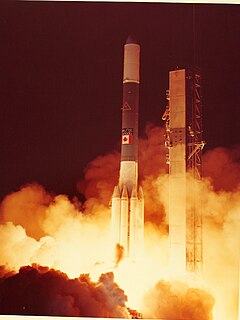
The Indian National Satellite System or INSAT, is a series of multipurpose geostationary satellites launched by ISRO to satisfy the telecommunications, broadcasting, meteorology, and search and rescue operations. Commissioned in 1983, INSAT is the largest domestic communication system in the Indo-Pacific Region. It is a joint venture of the Department of Space, Department of Telecommunications, India Meteorological Department, All India Radio and Doordarshan. The overall coordination and management of INSAT system rests with the Secretary-level INSAT Coordination Committee.
Eutelsat 133 West A is a Eutelsat operated Eurobird satellite, used primarily for digital television. It was launched in March 2001, and after a short period testing at 33°E, joined Eutelsat 2F4 at 28.5°E in the Clarke Belt, just within the range of satellite dishes pointed at SES' Astra 2 satellites at 28.2° east. It moved to 33° east and joined Eutelsat 33B in July 2015. Then it was moved to 133° west.
This is a list of the satellites operated by Optus, an Australian telecommunications company. The satellite communications facility is located at Belrose on Sydney's Northern Beaches. Optus' satellites are divided into 4 classes A, B, C and D. As of April 2014 it owns and operates Optus B3, Optus C1, Optus D1, Optus D2 and Optus D3. Optus A1, Optus A2, Optus A3 and Optus B1 satellites have been retired. Optus has the largest network of satellites in Australia and New Zealand.

The Anik satellites are a series of geostationary communications satellites launched for Telesat Canada for television, voice and data in Canada and other parts of the world, from 1972 through 2013. Some of the later satellites in the series remain operational in orbit, while others have been retired to a graveyard orbit. The naming of the satellite was determined by a national contest, and was won by Julie-Frances Czapla of Saint-Léonard, Québec. In Inuktitut, Anik means "little brother".

The National Space Research and Development Agency (NASRDA) is the national space agency of Nigeria. It is a parastatal under Federal Ministry of Science and Technology. The agency is based in the Nigerian capital city of Abuja and has a ground receiving station, among various other sites. It has had cooperation in space technology with the United Kingdom, China, Ukraine and Russia. The agency has struggled with meeting its financial plans and some of its facilities are rundown. Despite this, the space agency is one of the most advanced space agencies in Africa, boasting of four satellites and very grand ambitions. Nigeria's satellites have been praised for their high-resolution images.
Türksat is the name of a series of Turkish communications satellites operated or projected by the state-owned Türksat A.Ş.
Nigerian Communications Satellite (NIGCOMSAT) Limited is a company under the supervision of the Federal Ministry of Communications.
ChinaSat is the brand name of communications satellites operated by China Satellite Communications.
AMOS-3, also known as AMOS-60 is an Israeli communications satellite operated by Spacecom Satellite Communications.
Astra 4A is one of the Astra communications satellites owned and operated by SES at the Astra 5°E orbital slot providing digital television and radio broadcasts, data, and interactive services to Nordic countries, eastern Europe and sub-Saharan Africa in the 11.70 GHz-12.75 GHz range of the Ku band and 18.8 GHz-21.75 GHz range of the Ka band.
VeneSat-1, also known as Simón Bolívar, was the first Venezuelan satellite. It was designed, built and launched by the CGWIC subsidiary of the China Aerospace Science and Technology Corporation. It was a communications satellite operating from a geosynchronous orbit. It was launched on a Chinese Long March 3B carrier rocket from Xichang Satellite Launch Center Launch Complex 2 on 29 October 2008 at 16:53 UTC.
The AT&T satellite fleet is a group of communications satellites located at various geostationary orbits that AT&T uses for the DirecTV satellite television service and HughesNet internet service. The "DirecTV" prefix in their names has been changed to "T".
Afghansat 1, formerly named Eutelsat W2M, Eutelsat 48B, Eutelsat 28B is a telecommunications satellite operated by Afghanistan's Ministry of Communications and Information Technology.
Paksat-1R is a geosynchronous and communications satellite that was manufactured by China Great Wall Industry Corporation (CGWIC) and operated by the Space and Upper Atmosphere Research Commission (SUPARCO), an executive space authority of the Government of Pakistan.
Sino Satellite Communications Co., Ltd. known also as SinoSat is a Chinese company.
Intelsat 15, also known as IS-15, is a communications satellite owned by Intelsat. Intelsat 15 was built by Orbital Sciences Corporation, on a Star-2.4. It is located at 85° E longitude on the geostationary orbit. It was launched from Baikonur Cosmodrome to a geosynchronous transfer orbit on 30 November 2009 by a Zenit-3SLB launch vehicle. It has 22 active Ku band transponders, plus eight spares. Five of those transponders are owned and operated by SKY Perfect JSAT Group under the name JCSAT-85.
The Nigerian government has commissioned the overseas production and launch of four satellites.
Superbird-A2, known as Superbird-6 before launch, was a geostationary communications satellite ordered and operated by Space Communications Corporation (SCC) that was designed and manufactured by Hughes on the BSS-601 satellite bus. It had a mixed Ku-band and Ka-band payload and was expected replace Superbird-A at the position at 158° East longitude. It was expected to provided television signals and business communications services throughout Japan, South Asia, East Asia, and Hawaii.
Intelsat 10-02 is a communications satellite operated by Intelsat. Intelsat 10-02 is the first operational communications satellite to have its service life extended by Mission Extension Vehicle-2, while still in service, in 2021.

Alcomsat-1 is the first Algerian communications satellite. It was carried by Chinese launcher Long March 3B from the Xichang Satellite Launch Center, located in Sichuan Province, 2,200 km southwest of Beijing.



